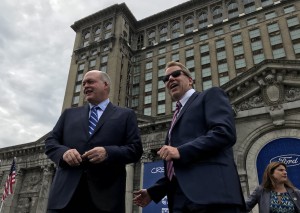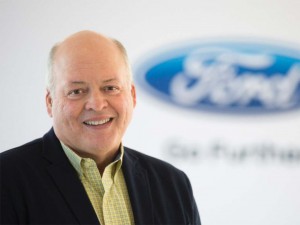When Jim Hackett was named CEO of Ford Motor Co., following a senior management shake-up last year, he promised to spend the next 100 days studying the company’s strengths and weaknesses to devise a clear turnaround strategy.
A year later, however, analysts and investors are still wondering what’s in store. The company has announced a few key elements of its plan, starting with the announcement that it will all but abandon the passenger side of the U.S. new car market to focus on the more profitable SUVs, CUVs and pickups that have come to dominate the sales charts.
Confusion about where Ford is heading with a turnaround plan it now values at $25.5 billion has translated into a sharp slump in its stock price, shares falling by more than a quarter this year, barely nudging the $10 mark all summer. Meanwhile, Ford’s debt rating has tumbled to just a bare step above junk status.
Complicating matters, the automaker has found itself in an ongoing war of words with President Donald Trump, who has been giving it grief about plans to import vehicles since shortly after launching his campaign for the White House. Just last week, after Ford said it would scrap plans to sell the Focus Active model because of new tariffs on Chinese-made vehicles, Trump tweeted that the crossover “can now be built in the U.S.A.”
(Trump puts Ford in Twitter crosshairs about China-built Focus. Click Here for the story.)

Ford CEO Jim Hackett, left, and Chairman Bill Ford celebrate the plan to refurbish the Michigan Central Station in Detroit for its Mobility campus.
Except it won’t be, Ford spokesman Mike Levine quickly firing back in his own tweet that, “It would not be profitable to build the Focus Active in the U.S. given an expected annual sales volume of fewer than 50,000 units and its competitive segment.”
Ford clearly would rather not be locked in a Twitter battle with the White House, but even without that, the company is struggling to rebuild the sort of confidence analysts, investors – and buyers – had in the company when it emerged from the Great Recession as the only Detroit carmaker not to have to declare bankruptcy.
For his part, Chief Financial Officer Bob Shanks admits Ford has to take some of the blame for the image problems it’s currently facing. “We haven’t yet been fully transparent … except at a very high strategic level,” the CFO told TheDetroitBureau.com during an interview. That is something he promised Ford will try to change, but Shanks also said he wasn’t able to comment on one of the key questions facing the company: will it be launching a major round of job reductions in the coming months and, if so, how big will the cuts be.
It’s hard to argue Ford doesn’t have room to trim its workforce. One unpleasant metric reveals how badly it lags the competition, particularly General Motors In 2017, its long-time rival sold 52.7 vehicles per employee. At Ford, the number was an anemic 32.8. But what improved efficiencies might mean in terms of potential job cuts is something Shanks said Ford isn’t ready to discuss.
Shanks came close, acknowledging there will be cuts to “capacities,” and while he wouldn’t be specific about timing, he essentially confirmed there will be job cuts, “a good portion (of which) will occur outside North America.”
If what some key analysts are forecasting comes true, those cuts could be substantial. “At this stage, we have assumed global headcount reduction of approximately 12%,” said a recent report by Morgan Stanley, which would work out to about 24,000 of Ford’s 202,000 workers worldwide. “Such a magnitude of reduction is not without precedent in the auto industry.”
There’s no question Ford has serious problems. The past year “was our best year ever” from a profit standpoint, said Shanks, but Ford’s broader performance “has been declining since 2016. We’ve seen growth in reverse and performance in decline.”
Latin America, Europe, Asia Pacific and the Middle East have been hemorrhaging cash for several years, collectively going about $800 million into the red during just the first half of this year. The automaker has been struggling even in China, the world’s largest automotive market, where key competitors like GM and Volkswagen generate significant profits.

Ford is moving its autonomous vehicle and EV business and strategy teams to "The Factory" in Detroit's Historic Corktown neighborhood.
(Click Here for more about Ford’s mobility plans and its new Detroit campus.)
That’s really left only North America to keep the balance sheet propped up, and even at home, things “are not as strong” as they were earlier in the decade, said Shanks, when Ford was generating margins of 8 to 11% in its home market.
Clearly, he stressed, the primary focus of the ongoing turnaround will be overseas operations, especially Europe and Latin America. There have been rumors that Ford might even try to partner or sell off some of its operations abroad, much as rival GM did when it closed the deal last year to sell German-based Opel-Vauxhall to France’s PSA Group.
So far, Ford has denied such plans. “We see the need to partner much more extensively than in the past,” said Shanks, pointing to deals with automakers like India’s Mahindra and Mahindra and Germany’s Volkswagen, as well as Chinese technology giant Baidu and Silicon Valley’s Amazon.
While job cuts, perhaps even some plant closures, seem certain to follow as Ford moves ahead with its turnaround plan, it isn’t just going to take a scorched field approach. It expects to include at least $6 billion in improved capital efficiencies, for example. And it expects to target ways to improve its marketing efforts, as well. Look for new ways to target and talk to customers “one-to-one,” the CFO suggested.
Then there’s that product portfolio. On the down side, Shanks said, “we allowed (it) to age compared to the competition,” and not evolve with a fast-changing market. But, pointing to products like the new Lincoln Aviator SUV, he insisted, “We’re just now entering a launch period that will be sweet (and introduce) products not in the market today (that will) give us a boost.”
The turnaround plan doesn’t entirely abandon some of the critical strategies set in place by former Ford CEO Mark Fields. If anything, successor Hackett has been a strong proponent of turning Ford into a “mobility company.” The new CEO has committed close to $1 billion to set up a new campus in the reviving Corktown neighborhood of Detroit, for one thing, to develop plans and technology for self-driving vehicles and other mobility alternatives, as well as electrified vehicles. An alliance with Amazon is just one of the efforts to increase the focus on connectivity.
“A lot of the (reorganization) is about making different choices about strategy,” said Shanks, adding that the goal isn’t to just slash spending but to improve Ford’s “fitness.”
Ford is by no means the only automaker facing uncertainty. Crosstown rivals General Motors and Fiat Chrysler, are also struggling to buoy their stocks, as are many foreign-based manufacturers.
It doesn’t help to have President Trump hamstringing the industry beyond what he might say in a tweet. Ford has estimated it will wind up spending as much as $1.5 billion more this year on commodities because of the new import steel and aluminum tariffs. And then there are the other aspects of the trade war made apparent by the decision to kill the Focus Active model. Things could get even worse if Trump kills the North American Free Trade Agreement, throwing a cross-border manufacturing network built up over a quarter-century into chaos.
That could complicate things for Ford’s promise to be more transparent about its plans – while also showing it can deliver – so it can convince analysts, investors and ratings agencies buy in.
(To see more about Ford’s plans for its autonomous vehicle unit, Click Here.)
“Like so much of the Ford investment thesis,” Morgan Stanley’s automotive research team recently wrote, this is “a show-me restructuring and capital realignment story. Investors are still wanting more action in the form of decisive restructuring, business unit transparency, capital allocation and external validation.”


